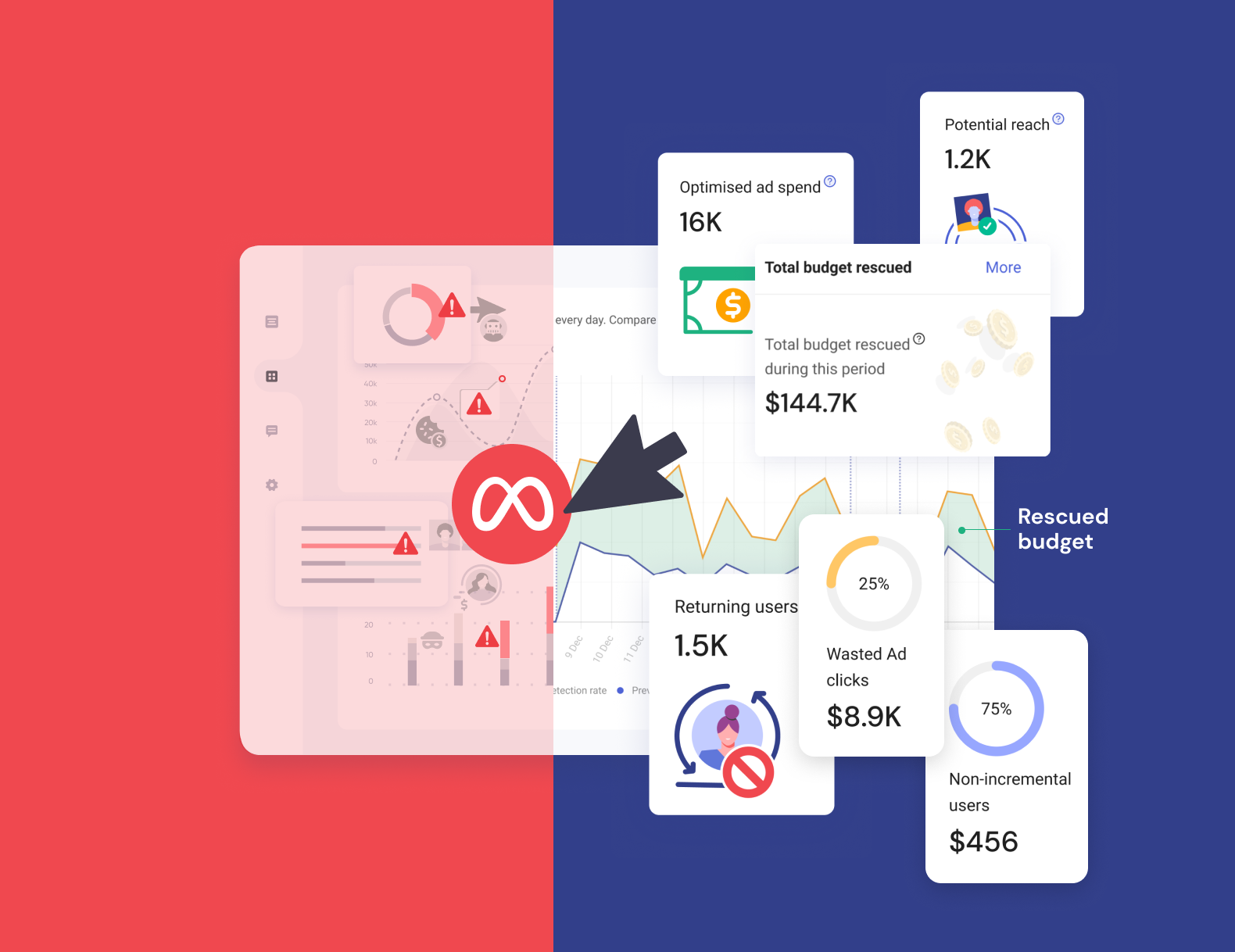7 Effective Ways to Stop Click Fraud in Your Campaigns

What if 1 in 5 clicks you're paying for was never going to convert?
What if your campaign was being fuelled by bots, competitors, or repeat visitors who never intended to convert? Either way, they’re draining your budget and skewing your data.
Click fraud isn’t just an operational glitch or performance hiccup. It drains budgets, pollutes analytics with false signals, and forces marketers to optimise based on distorted data. Left unchecked, it leads to underperforming campaigns, misallocated spend, and misleading ROI across the board.
In this blog, we’ll unpack 7 effective ways to stop click fraud before it sabotages your next campaign. Whether you’re running paid search, mobile, affiliate, or paid social, the solutions below are designed to help you take back control.
Why Click Fraud Is Still a Major Threat in 2025
Click fraud has evolved. What used to be isolated incidents from suspicious IPs or one-off bad actors has evolved into a constant, automated assault. Botnets, click farms, competitor abuse, and repeat-user inflation now compromise every major ad channel, from Google Ads to Meta.
These invalid clicks don’t just waste spend. They corrupt attribution, skew optimisation models, and pollute remarketing audiences. Without proactive click fraud protection, the data that drives your decisions becomes unreliable.
7 Ways to Stop Click Fraud in Your Campaigns
1. Monitor Unusual Click Patterns in Real-Time
Click fraud does not go unnoticed if you know where to look.
Real-time monitoring helps you flag red flags early:
- Sudden spikes in clicks without a corresponding lift in conversions
- Abnormally high click-through rates paired with bounce rates
- Repeat clicks from the same IP or ISP
These signals are often signs that your campaigns are being targeted by bots, scripts, or rogue affiliates. The longer they run undetected, the more damage they cause.
TrafficGuard for Google Search protects your Google Ads campaigns from click fraud by detecting and blocking invalid traffic in real time, while providing live analytics to help you respond before your budget is wasted.
2. Set IP and Geo-Based Exclusions
Click fraud often originates from specific IP addresses, proxy servers, or regions known for invalid traffic.
For advertisers running geographically targeted campaigns, clicks from outside your intended market can signal trouble. Implement IP and geo exclusions based on performance data, not assumptions. Monitor regions with poor conversion rates and high bounce activity, and exclude traffic accordingly.
Regularly update these lists. Fraud tactics shift frequently, and exclusions must evolve in response.
3. Cap Ad Frequency Per User or Session
If a single user clicks your ad ten times in one session, chances are they’re not a legitimate prospect.
Frequency caps help limit how often a person can interact with your ad, reducing wasted spend and protecting your campaigns. This is especially important for branded keywords in Search campaigns, where repeated clicks often come from non-malicious navigational traffic that would likely reach you organically.
With TrafficGuard, you can create customisable validation rules enabling automated prevention, increasing efficiency and creating opportunities to acquire new, valuable users.
4. Use Click Fraud Protection Software
Manual efforts only go so far. Dedicated click fraud prevention software is essential to automatically detect and block fraudulent activity in real time.
Solutions like TrafficGuard verify clicks before attribution, block invalid traffic at the pre-bid stage to safeguard your campaign’s performance and reporting.
TrafficGuard empowers marketers to safeguard their advertising budgets across a diverse range of platforms including Google Ads, Meta (Facebook & Instagram), mobile app networks, and affiliate channels. By detecting and blocking invalid traffic in real time, TrafficGuard ensures that every click, impression, and conversion is legitimate. This comprehensive protection enhances campaign performance, improves return on ad spend (ROAS), and provides marketers with greater confidence in their data and control over their advertising investments
If you cannot identify where invalid traffic is coming from or how much it is costing you, you're guessing. That’s not sustainable. To get a clear view of your risk and where to take action, check out our Invalid Traffic Protection Checklist.
5. Regularly Review Ad Placement Reports
Where your ads appear matters just as much as who sees them.
Click fraud often hides in low-quality placements: spoofed domains, auto-refreshing pages, and poorly moderated apps that exist only to farm impressions. Review your placement reports often and identify any patterns of poor performance.
If you are running programmatic campaigns, insist on supply path transparency. Eliminate placements with inflated CTRs and no conversions, and use inclusion lists where possible.
6. Align Sales and Marketing on Lead Quality
Click fraud doesn’t stop at the ad level. It poisons downstream metrics too.
Low-quality leads, fake sign-ups, and unreachable contacts are often by-products of fraudulent clicks. If sales teams are struggling with lead quality, it may be because bots or fraudsters are filling the top of your funnel.
Open clear feedback loops between marketing and sales:
- Review the lead sources associated with bounce or churn
- Match conversion data to click anomalies
- Align on performance benchmarks for legitimate leads
The more aligned your teams are, the harder it is for fraud to hide behind inflated engagement numbers.
7. Track Session Engagement Beyond the Click
Not every click is valuable. Real users explore, scroll, and convert. Bots bounce.
By tracking user behaviour post-click, you can distinguish between real engagement and automated activity. Look at:
- Time on site
- Scroll depth
- Interactions with on-page elements
- Form completion or cart activity
Patterns that suggest no meaningful interaction are red flags. Feed this data back into your fraud prevention strategy to improve accuracy and response times.
Still think your ads are under attack? You’re probably right.
Run the numbers with our Invalid Traffic Calculator to see how much you’re really losing. Fraud won’t wait and neither should you. Get the practical framework you need to act fast and shut it down in our guide: Building a Click Fraud Response Plan.
FAQs and Key Takeaways
- Why is click fraud still a major threat in 2025?
Because it has evolved. Bots are more sophisticated, human click farms are harder to detect, and bad actors now operate with precision. Click fraud infiltrates paid search, mobile, affiliate, and paid social campaigns. Without dedicated protection, marketers are exposed to budget waste, flawed optimisation, and misleading analytics. - How does click fraud affect my campaign performance?
It misleads every step of the journey. From inflated CTRs and polluted remarketing lists to poor-quality leads and misallocated budget, invalid traffic distorts your entire funnel. The result is wasted spend and campaigns that appear to perform well but fail to drive real business outcomes. - What’s the best way to prevent click fraud in real time?
Use dedicated click fraud prevention software. Platforms like TrafficGuard detect and block threats before they enter your reports, verify traffic quality across all major ad platforms, and give you real-time visibility into where your ad spend is going.
Get started - it's free
You can set up a TrafficGuard account in minutes, so we’ll be protecting your campaigns before you can say ‘sky-high ROI’.
Subscribe
Subscribe now to get all the latest news and insights on digital advertising, machine learning and ad fraud.








